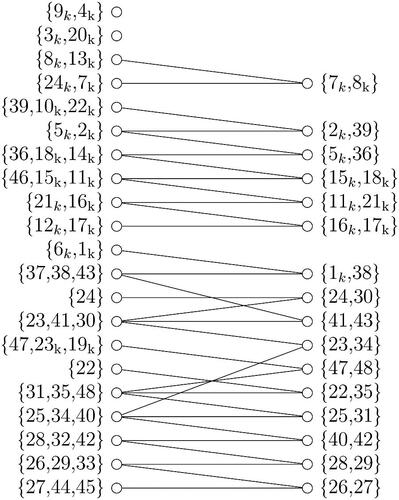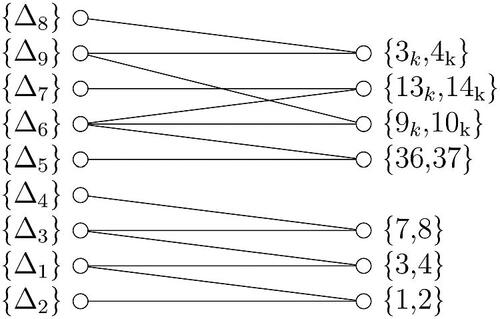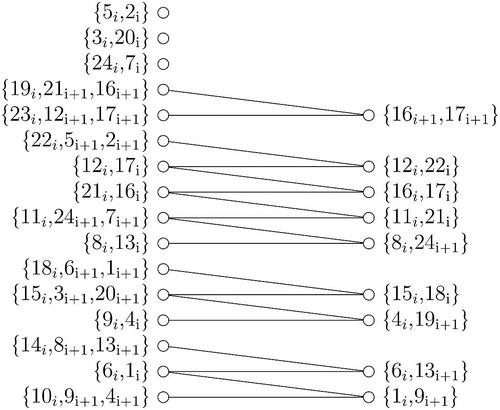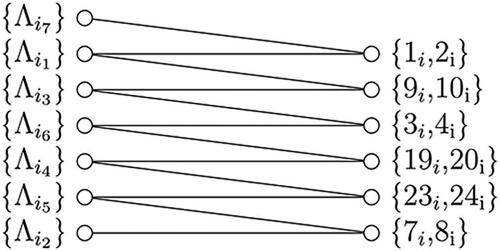 ?Mathematical formulae have been encoded as MathML and are displayed in this HTML version using MathJax in order to improve their display. Uncheck the box to turn MathJax off. This feature requires Javascript. Click on a formula to zoom.
?Mathematical formulae have been encoded as MathML and are displayed in this HTML version using MathJax in order to improve their display. Uncheck the box to turn MathJax off. This feature requires Javascript. Click on a formula to zoom.Abstract
Here we prove that the alternating group of degree n is a faithful completion of the Goldschmidt G3-amalgam if and only if
2020 Mathematics Subject Classification:
1 Introduction
In [Citation3] Goldschmidt classified the primitive rank 2 amalgams of index (3, 3). These amalgams are now referred to as Goldschmidt amalgams. We recall that a rank 2 amalgam consists of groups P1, P2, and B together with group monomorphisms such that
Suppressing the , we refer to this amalgam as
. To say
is primitive means that if
and
for i = 1, 2, then K = 1. If P1 and P2 are finite groups, then
is called a finite amalgam whose index is
. A group G is said to be a completion of
if there exist group homomorphisms
i = 1, 2, for which
and
. Should the
, be monomorphisms we then say this is a faithful completion. Here we shall only consider faithful completions, and so from now on will identify Pi
with
and B with
. Hence we have
with
and
(though in all the completions we deal with we will have
). We remark that faithful completions of these Goldschmidt amalgams furnish, via their coset graphs, many examples of trivalent graphs.
The amalgams arrayed in [Citation3] consist of fifteen amalgams, among which is the Goldschmidt G3-amalgam. This amalgam has and
. A related Goldschmidt amalgam we shall briefly encounter is the
-amalgam. In this case we have
with
. By
we mean the symmetric group of degree n and
the dihedral group of order 8. We also use
to denote the alternating group of degree n. Some small examples of faithful completions of these amalgams are
and
. Taking P1 and P2 to be the two standard maximal parabolic subgroups of
yields a completion of the G3-amalgam. In
, letting P1 and P2 be, respectively, the centralizers of (1, 2) and
, we see that
is a completion of the
-amalgam. Intersection of P1 and P2 with
reveals that
is a completion of the G3-amalgam.
It is completions of the G3-amalgam we study here. Puttingwe state our main result.
Theorem 1.1.
Suppose that . Then
is a completion of the Goldschmidt G3-amalgam if and only if
.
Earlier work on the Goldschmidt G3-amalgam for alternating groups [Citation7] verified that for all is a completion precisely when
. In this paper we shall demonstrate that
is a completion for all
from which Theorem 1.1 will then follow. Conder, in [Citation2], investigated whether
is the automorphism group of some finite connected 5-arc transitive graph. Using the work of Lorimer [Citation4], Conder rephrases his problem to ask whether there exists
and
such that
;
; and
.
If such a subgroup H and element a can be found, then is a completion of the Goldschmidt
-amalgam, with
and
, which then implies that
is a completion of the Goldschmidt G3-amalgam (see Lemma 2.3). Now Conder’s method is to assemble various transitive representations for
on
and 48 points and then taking appropriate combinations of these upon which a permutation that will fulfill the role of a is defined. This is achieved for all n of the form
, where
. Since the Frobenius number of {84, 176, 177}- the largest integer such that it cannot be formed as
for
- is 2743, it means that, taking into account the additional 87, for all
,
and
are respective completions of the Goldschmidt
- and G3- amalgams.
We briefly survey what else is known about completions of the Goldschmidt G3-amalgam. Which sporadic simple groups (with the sole exception of the Monster) are completions is settled in [Citation6] and [Citation7]. While in [Citation5] we have that and
are completions of the Goldschmidt G3-amalgam if and only if
. For the unitary and orthogonal groups,
and
are completions if and only if q is odd and
and
is a completion if and only if q or
is a prime and
.
This paper is arranged as follows—Section 2 begins with two elementary results concerning completions of the Goldschmidt G3-amalgam. Then we introduce a particular type of graph, the orbit graph . Here P1 and P2 are subgroups of
, the group of permutations on Ω. This graph, courtesy of Lemma 2.6, can be used to determine whether
is transitive on Ω or not. Definition 2.8 introduces the idea of twisting P1 with respect to
where Δ and
are certain
-orbits of disjoint sets Ω and Γ. This idea, via Lemma 2.9, plays a central role in the recursive construction, presented in Section 3, and which underlies the proof of Theorem 1.1. We end Section 2 with Theorem 2.10, a classical result of Jordan’s.
In Section 3 we give a detailed account of a recursive construction for the case when . For the remaining congruences we list, in Section 4, the seed permutations which enable this construction to produce an example of
as a completion of the Goldschmidt G3-amalgam. Further details on these seed permutations may be found in Section 3.
2 Some preliminary results
We begin with a hypothesis which lists all relevant facts about completions of the Goldschmidt -amalgam which we use.
Hypothesis 2.1.
When G is a (faithful) completion of the Goldschmidt G3-amalgam this means that G contains subgroups P1 and P2 such that
and
;
; and
(where
is the largest normal 2-subgroup of Pi).
Our first result concerns involutions and completions of the Goldschmidt G3-amalgam.
Lemma 2.2.
Suppose the group G is a completion of the Goldschmidt G3-amalgam . Then the involutions in
are G-conjugate.
Proof.
By Hypothesis 2.1 we have with
and
. Now, for i = 1, 2 Pi
has two conjugacy classes of involutions
and
with
. Since
and
, Lemma 2.2 follows. □
Next we see that a completion of the Goldschmidt -amalgam,
, for
yields a completion of the Goldschmidt G3-amalgam for
.
Lemma 2.3.
If is a completion of the Goldschmidt
-amalgam, then
is a completion of the Goldschmidt G3-amalgam.
Proof.
Set and
. Let
be such that
and
with
. Also put
and
. Observe that
for otherwise
and then
, a contradiction. Further we must have
. Note that
and that R1 and R2 normalize each other. Since
is primitive,
. From
, we then see that
. So
has order 8 and either
is abelian or
. If the former holds, then
for i = 1, 2, giving the impossible
. Therefore,
. Since
for i = 1, 2, we have
or
. The former possibility doesn’t contain a
subgroup and therefore
. To complete the proof we must show that
. Now B normalizes
and so
We recall that so
is simple, whence
. □
In proving Theorem 1.1, for specified subgroups P1 and P2 of we need to show that
. Not surprisingly, our first step is to prove that
acts transitively on
. This leads us to consider a particular type of graph which we now define.
Definition 2.4.
Suppose G is a finite group acting on a finite set Ω with P1 and P2 being subgroups of G. Let and
be, respectively, the P1- and P2-orbits on Ω (and we shall regard these sets as being disjoint). The orbit graph of P1 and P2,
, has vertex set
with distinct vertices
and
adjacent whenever their intersection contains a
-orbit and the number of edges between them is the number of
-orbits in
.
We observe that is a bipartite graph and that
and
being adjacent is equivalent to
(as subsets of Ω). We next give two examples of Definition 2.4—note that in Example 2.5(ii) we have that P1 and P2 have the same orbit (namely Ω), but we consider them to be distinct vertices of
.
Example 2.5.
and
where
Here, the B-orbits on Ω are and
. The P1-orbits are
and the P2-orbits are
. So the orbit graph
is as given in .
and
where
and
In this case, the B-orbits on Ω are and
with both P1 and P2 acting transitively on Ω. Thus
is as shown in .
Example 2.5
(ii) plays a central role in proving Theorem 1.1.
Lemma 2.6.
Suppose , Ω a finite set. Then
is transitive on Ω if and only if
is connected.
Proof.
Let and
be, respectively, the P1- and P2-orbits on Ω. Suppose
acts transitively on Ω and let
and
be vertices of
. Choose
and
. Then
for some
. Now
where
, and, as
implies
, we may assume
. Put
and let
be the P2-orbit such that
. Then
whence
and
are adjacent in
. Continuing in this fashion yields a path from
to
. Therefore
is connected.
Now suppose that is connected, and let
. Let
. We may find a sequence of P1- and P2-orbits in which the
th and
th orbits have non-empty intersections. This then gives
for which
, and so
is transitive on Ω. □
Hypothesis 2.7.
Suppose G and H are subgroups of, respectively, and
where Ω and Γ are finite sets which are disjoint. Assume that G contains subgroups Q1 and Q2 with
and that H contains subgroups R1 and R2 with
. Further assume that
, are isomorphisms for which
for all
. For
we regard x as a permutation on
by letting x act as the identity on Γ and
as a permutation on
by letting
act as the identity on Ω. Define subgroups
of
by
and
.
We sometimes refer to as being the concatenation of
and
. Note that
and
.
Definition 2.8.
Assume Hypothesis 2.7 and let Δ and be B-orbits of, respectively, Ω and Γ which are isomorphic B-sets. Now let
be an involution in
which interchanges Δ and
and fixes all other points of
. Then we refer to the conjugate
as twisting P1 (with respect to
).
We note in Definition 2.8 that .
Lemma 2.9.
Assume Hypothesis 2.7 holds, and use the notation given there. Let where Δ and
are B-orbits of Ω and Γ respectively which are isomorphic B-sets. Suppose
is transitive on both Ω and Γ. Then
is transitive on
if and only if the edge in
corresponding to Δ or the edge in
corresponding to
is part of a cycle in the graph
.
Proof.
By Lemma 2.6, as is transitive on Ω and Γ,
and
are both connected graphs. Suppose
and
where
are, respectively P1- and P2-orbits of Γ and
are respectively P1- and P2-orbits of Γ. So
and
are adjacent in
and
and
are adjacent in
. Since
fixes all points in
has the same orbits on
as P1 except
and
get replaced by
and
. Thus
and
, whence
and
are adjacent, as are
and
in
. Since
is transitive on
if and only if
is connected, the lemma now follows. □
The following theorem is a classical one of Jordan’s, which appears as Theorem 13.9 in [Citation9]. This theorem suffices for our work. However, in [Citation8], a generalization of this result is needed to deal with some of the other cases.
Theorem 2.10.
(Jordan) Let G be a primitive permutation group of degree n with a cycle of degree where p is prime. If
, then
or
.
3 A recursive construction
Put and let
be the standard G-set. Bearing in mind Lemma 2.2, we are looking for G-conjugate involutions which generate appropriate
subgroups of G. Thus we seek conjugate involutions x, y, z, and w of G such that the following is satisfied.
Hypothesis 3.1.
is conjugate to x;
and zx = xz;
and wy = yw;
zy and wx both have order 3; and
These conditions will ensure that for and
we have
and
.
As indicated earlier Example 2.5(ii) will be important, one reason being given in our next result.
Lemma 3.2.
Let , and P2 be as in Example 2.5(ii). Then
and
. Thus (P1, P2) yields
as a completion of the Goldschmidt G3-amalgam.
Proof.
It is straightforward to verify Hypothesis 3.1(i)–(iv) for . So it remains to show that (v) holds. Since
is connected, Lemma 2.6 implies
acts transitively on Ω. Calculation reveals that
has cycle type
. So
is a 19-cycle. Hence, all the points of Ω in this 19-cycle either lie in the same block of a
-system of imprimitivity or they all lie in separate blocks. So any
-system of imprimitivity must either have block size at least 19 or at least 19 blocks. Since
acts transitively on Ω and
, we conclude that
acts primitively on Ω. Furthermore, the presence of a 19-cycle, by Theorem 2.10, confirms
, so proving the lemma. □
We are now in a position to expand on the details of the recursive construction. Now Example 2.5(ii) shows where
has cycles and hence Lemma 2.9 becomes available to us. Put
, acting on
and suppose
are subgroups of Gm
with
and
with
(so Gm
is a completion of the Goldschmidt G3-amalgam). Also let
with H acting upon
with
subgroups of H such that
is the completion given in Example 2.5 (
). Since the D-orbits on Γ are regular, to employ Definition 2.8 we require that
has a regular orbit on Ωm
. So we further assume that this is the case, letting
be such a regular
-orbit (we can achieve this by conjugating the
. Let
be the generators for Gm
as given in Hypothesis 3.1 which give
and
. So
and
. The corresponding generators for H are
where
and
and
is a regular D-orbit upon which, restricted to
.
Put . Then we may define subgroups
and
as in Hypothesis 2.7. Thus we have
and
. Now take
Then satisfies the conditions of Definition 2.8 and so we may twist P1 with respect to
. Because of Lemma 2.9 we have that
is a transitive subgroup of
which is actually a subgroup of
. Theorem 1.1 is proved (constructively) by beginning with an appropriate Gm
and appropriate
, and then “adding” copies of H. Thus the proof must consider twenty four cases given by the congruence of
where
. For the full details we direct the reader to [Citation8] or to the seed permutations given in Section 4 and here we will look at starting with m = 24 and repeatedly “adding” copies of H. We remark that recursive constructions of this ilk have also been employed in [Citation1] and [Citation6].
Definition 3.3.
If we begin with and recursively add on copies of H, then any points greater than m will be denoted with numbers
with an appropriate subscript attached. Explicitly, the number
will be denoted
for
. In simpler terms, this will see the ith set of 24 points to be labeled
for
. The points
can be considered as having the subscript 0 attached, which will be useful in writing down the cycle decomposition of z but not generally noted otherwise.
The labels ji
and will be interchangeable depending on which is most convenient.
Theorem 3.4.
For is a completion of the Goldschmidt G3-amalgam.
Proof.
Starting at m = 48, we take the following elements for
For convenience we will denote simply as
throughout this proof. Put
.
We consider and show that H fixes 19 and is transitive on
. Hence
is 2-transitive on Ω. In fact, the generator x is not necessary here but it will simplify the proof. First we look at
and see that
The following subgraphs of will help to show that H is transitive on
, where the orbits of
are on the left hand side and orbits of
are on the right. For the moment we assume
, dealing with k = 0, 1 later.
Looking at and , the following are subsets of H-orbits:
and
However, when also considering orbits of , we can connect these further as in , which shows that
and
are subsets of H-orbits, with
.
When , shows that the following are subsets of H-orbits.
Now, considering the orbits of we can see that
is a subset of an H-orbit with the help of . Clearly, there are more points with subscript i + 1 that we could include, but all we require is that there is at least one, hence
and therefore,
, where Γ is an H-orbit. Since
contains points with subscript 1- all of which are in
, so
also. Finally,
so
and
are H-orbits. Consequently
is 2-transitive when
.
Next we look at the case k = 0. For k = 0, consider ,
This is a 47-cycle, so clearly H is transitive on .
Finally we consider the case k = 1. Then
Here, z contains the transpositions and (60, 70). These transpositions (ignoring the cycle (19)) connecting the first and fifth cycle of
, second and third, fourth and second and fifth and second cycles respectively. That is to say, they contain one point from each therefore proving that all of the points in both of those cycles must belong to the same H-orbit- so forming the H-orbit
.
Consequently for all
is 2-transitive.
Now we are in a position to demonstrate that , using the element zw. For the moment we assume that
.
Observing the cycle decomposition of zw leads to us noticing that it follows patterns depending on the value of . When
, we analyze the cycles in zw. Here, the underlined parts of the cycle are “repeated,” only with the subscript on the points in subsequent or previous repeated parts being respectively higher or lower by the same amount with each repetition;
, (9, 19, 10), (23, 33, 34), (25, 45, 31), (28, 29, 44),
So, by counting the lengths of these cycles, we see zw is an element of cycle type for which we can see the first two cycles are of odd length and the third will be divisible by 2 but not 4. Overall, this means that the only cycle of length divisible by 8 is the 8-cycle above.
When we have the following cycles;
, (9, 19, 10), (23, 33, 34), (25, 45, 31), (28, 29, 44),
,
All of this gives a cycle type of
, for which we can see that the first four cycles will all be of odd length and no others divisible by 8 other than the 8 cycle.
In both cases, for some large odd number f, and
so
and
is a 3-cycle, sufficient by Theorem 2.10 to confirm that
.
It remains to deal with the exceptional case k = 0. Here, , of cycle type
and
is an 11-cycle, sufficient by Theorem 2.10 to confirm that
.
So for all , which completes the proof of Theorem 1.1 in the case
. □
4 Seeds for the recursive construction
The following generators provide a starting point for the recursive method of adding 24 points for each case modulo 24. In each case is a regular
-orbit with
and
on this orbit. So, we can take
and
as the two orbits to twist by.
When , we may start at m = 24 with:
When , we may start at m = 25 with:
When , we may start at m = 26 with:
When , we may start at m = 27 with:
When , we may start at m = 28 with:
When , we may start at m = 29 with:
When , we may start at m = 30 with:
When , we may start at m = 31 with:
When , we may start at m = 32 with:
When , we may start at m = 33 with:
When , we may start at m = 34 with:
When
, we may start at
with:
When , we may start at
with:
When , we may start at
with:
When , we may start at
with:
When , we may start at
with:
When , we may start at
with:
When , we may start at
with:
When , we may start at
with:
When , we may start at
with:
When , we may start at
with:
When , we may start at
with:
When , we may start at
with:
When , we may start at
with:
References
- Bundy, D. M., Rowley, P. J. (2006). Symmetric groups and completions of the Goldschmidt amalgams of type G1 . J. Group Theory 9(5):627–640.
- Conder, M. (1988). An infinite family of 5-arc-transitive cubic graphs. Ars Combin. 25(A):95–108.
- Goldschmidt, D. M. (1980). Automorphisms of trivalent graphs. Ann. Math. (2) 111(2):377–406. DOI: 10.2307/1971203.
- Lorimer, P. (1984). Vertex-transitive graphs: Symmetric graphs of prime valency. J. Graph Theory 8(1):55–68. DOI: 10.1002/jgt.3190080107.
- Parker, C., Rowley, P. (2000). Classical groups in dimension 3 as completions of the Goldschmidt G3 -amalgam. J. London Math. Soc. (2) 62(3):802–812.
- Parker, C., Rowley, P. (2001). Sporadic simple groups which are completions of the Goldschmidt G3 -amalgam. J. Algebra 235(1):131–153.
- Parker, C., Rowley, P. (2002). Finite completions of the Goldschmidt G3 -amalgam and the Mathieu groups. Commun. Algebra 30(12):5611–5619.
- Vasey, D. M. (2014). Alternating groups as completions of the Goldschmidt G3 -amalgam. PhD thesis. University of Manchester.
- Wielandt, H. (1964). Finite Permutation Groups. London/New York: Academic Press.







